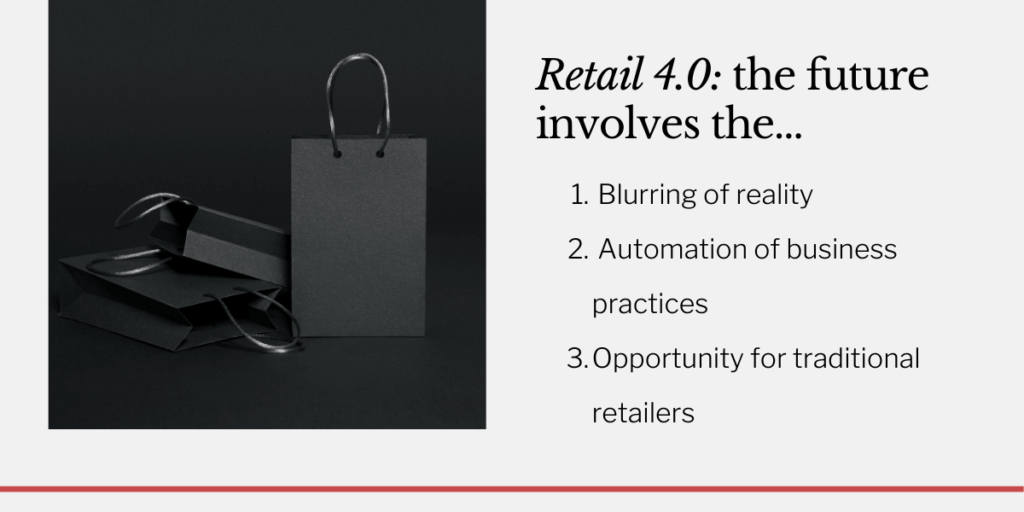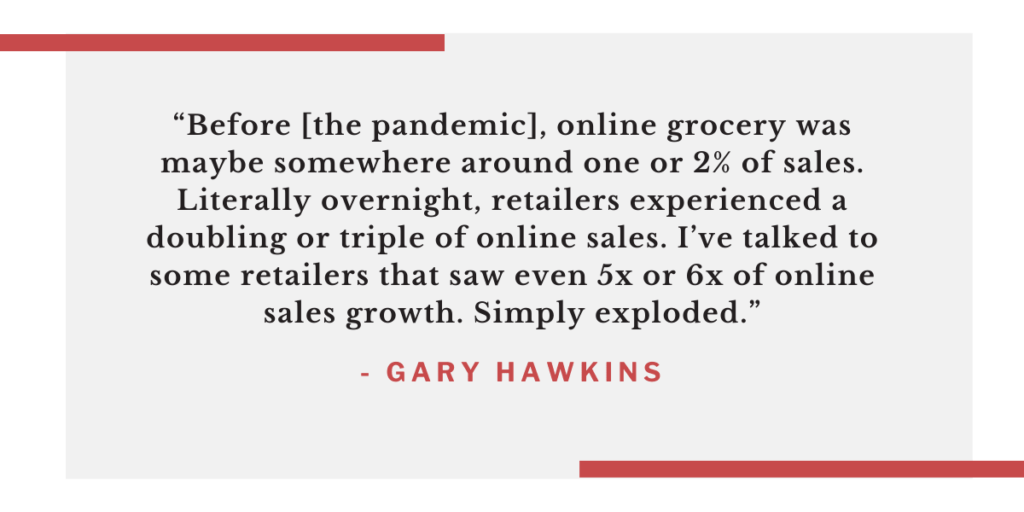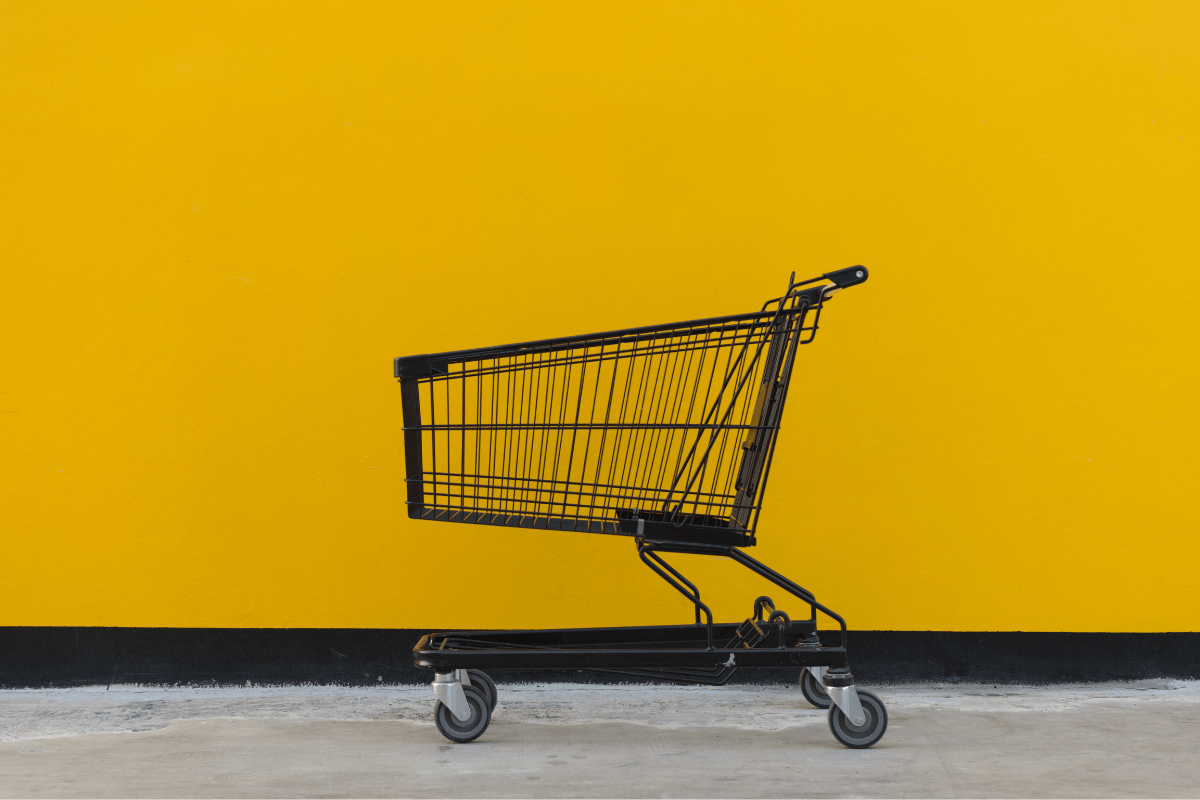In November, we had the pleasure of being joined by Gary Hawkins, founder and CEO of the Center for Advancing Retail Technology (CART), on KG Connects. Hosted by Ketner Group CEO, Jeff Ketner, Gary walked listeners through what the digital evolution of grocery means for retailers and shoppers alike.
CART connects retail to new innovative capabilities through programs, events and education. Additionally, Gary is a highly sought-after strategic adviser and speaker, as well as a board member of companies that bring game-changing capabilities to market. He has written three books, Retail in the Age of i being the latest.
Below you can find a full summary of the webinar. If you’d like to view it on demand, you can check it out on Zoom here.
Retail 4.0: What the future of grocery retail entails
To set the stage, Gary and Jeff first discussed Gary’s latest whitepaper, “Retail 4.0: The Age of Metamorphosis” reveals the current and future changes expected in the grocery industry. There are three key themes Gary focuses on.
The first is the blurring of reality.
As Gary explained, “The world of digital, the online world is meeting and fusing together, melding with the actual physical world. As these things come together, it’s absolutely beginning to change and transform how we shop.”

The majority of people use their phones while they shop, which, according to Gary, opens the door to not only incredible amounts of information, but also augmented reality. As augmented reality technology continues to improve, the in-store experience will begin to utilize it more and more.
The second theme is the automation of business practices.
“Instead of a physical robot, we’re talking software robots that can begin to automate the decision-making process in a growing number of areas across the retail organization.”
The third theme is the opportunity for traditional retailers. Specifically, the ability for these retailers to, “play the exponential value creation game building out their digital networks.”
Who’s spearheading the future of grocery retail?
After the closer look into Retail 4.0, Jeff asked a rather simple question, “Who is doing it right?”
Who else but Amazon?

“The new Amazon Fresh Farm…They’ve brought Alexa into the store now,” Gary described, “if a shopper has a question, they don’t have to seek out a clerk, they simply go to an Alexa station and ask their question.”
Which ties right back to the first key theme in Retail 4.0.
The pandemic’s impact on retail
When asked about the role of COVID-19 on the grocery industry, Gary had one word—Accelerant.
“Before [the pandemic], online grocery was maybe somewhere around one or 2% of sales. Literally overnight, retailers experienced a doubling or triple of online sales. I’ve talked to some retailers that saw even 5x or 6x of online sales growth. Simply exploded.”
Gary continued by explaining that the growth has plateaued, allowing retailers to reassess their systems and ensure they are prepared for the foreseeable future.
He also noted that, “for an industry that has almost resisted innovation and change for the past 100 years, when they need to, retailers can move really fast.”
One area where he saw this unusual speed was employee communication. Retailers, typically through apps, were able to push out training for sanitation, coordinate messaging and rapidly changing scheduling for every associate.
Grocery innovation on the horizon
Being at the forefront of new technologies, Gary sees a lot of interesting new startups enter the retail space. One area that he is watching with a keen eye goes right back to the first theme of Retail 4.0: augmented reality.
“I saw a stat recently from Gartner that over 100 million people are using AR primarily through their smartphones. I think we are simply going to see that explode in the next 12 months as Apple introduce their smart glasses,” Gary continued, “I’m really looking to that technology to transform the shopping experience.”
Marketing to the individual shopper
Augmented reality isn’t the only cutting edge. Gary also lauded AI and machine learning’s current and future potential, as well as its ability to power key business systems such as personalization.
“It’s helping to facilitate the automation of different decisions. For example, it is more efficient for a mass retailer to go to market on an individual customer basis than it is to go to market with traditional mass promotion.”
While it would seem that meeting the individual preferences of shoppers may be harder to achieve, Gary explained that, at scale, the 1-to-1 marketing tactics will, in-fact, smooth supply chain issues by removing the spikes in unit sales caused by mass promotion.

While there are challenges to implementing this method, they aren’t caused by technology, but by retailers and brands themselves. Gary stated that retailers need to move away from over a century of thinking about how they do business.
This includes brand promotions as well.
“When you shift to a true 1-to-1 model, that changes how brands pay retailers to promote their brands to shoppers on a mass scale.”
The 2021 digital retail experience, and beyond
The fact is, in twelve months, we may find a very different retail experience in grocery stores that are on the cutting-edge of technology. Online grocery has had a major impact on the physical store, and Gary expects to see stores become hybridized between a traditional grocery store and a micro-fulfillment center.
“Every retailer is now focused on making online retail profitable, and when you’re sending people up and down the isles to fulfill those orders, it’s tough to get profitable,” Gary said.
Gary is seeing a, “stampede,” toward the automation and micro-fulfillment side of grocery retail. He expects that stores will begin to move the micro-fulfillment center to the back of the store, while the front half focuses on fresh foods and customer experience. Experience being the operative word according to Gary.
“If that store can’t provide an experience to get shoppers out of their home and into the store, they won’t be there,” and because grocery delivery is so prominent, he explained that, “the days of utility shopping are gone.”
Breaking into the grocery technology market
Gary was asked, “how do new technology companies market themselves to retailers?” While the inability to meet face-to-face makes marketing a challenge, Gary offered a bit of advice.
“Understand the space, the retailer’s challenges and needs and then work to craft that vision and story about why the retailer should be talking to you. Retailers need to focus on the vision — what’s coming — because things are moving really, really fast.”
Regional grocers can utilize technology to keep up with major retailers like Walmart. According to Gary, “it’s not about access to the technology, it’s about can that regional retailers change their culture? Can they move faster? Deploy things faster? Can they change their processes and how they think about their business?”

Hear it direct from Gary and sign up for the next KG Connects
If you’d like to watch the whole webinar, you can watch it on demand anytime.
The last one for 2020: Where in the H*LL Does the Future of Work Go From Here?”
As we wrap up 2020, we’re looking toward 2021 and how work will change even further than it has over the past year. Join Carolyn Birsky, Daniel Oppong and Sterling Hawkins as we dive deep into how to maintain a culture, recruit talent and keep some kind of normalcy all while remote. We look forward to seeing you! Register here for free.

